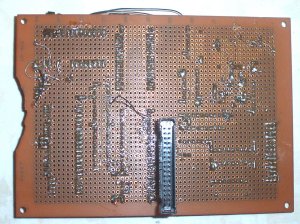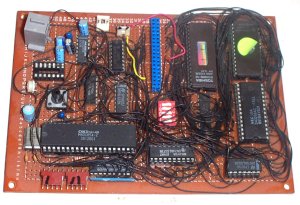Why I Cannot Sell These
Click on any picture for a larger view.

The original SID Player. I made this player some time in 1993. It was the first large project I undertook that made it all the way.
It is of fairly primative construction due to my lack of tools/knowledge/skill at the time. It's a wonder that it still works! There will not be much
theory discussed, since I have included the full schematic, and when I find it, the full source code for this project.

It uses a standard 4 line by 20 character LED backlit LCD display for output, a hacked up cellular telephone keypad (lights up green), 3 toggle
switches for entry, and a pot for volume, and a headphone jack (mono). The switch on the left is for power.

Looking down from the top, the 6581 is visible along with the glowing keypad. The upside down board is the power supply/audio amp board.

This top board contains the entire "C64" portion that was required to play tunes: 6510 processor, 6581 SID, 64K of RAM, decoding logic to map the SID chip in at D400-D7ffh, and the "bus interface" which allows the host to "poke" data into the 64K of "C64" RAM.

Bottom of same; the connector hooks it up to the second board.

This is the "host" board. It runs the user interface and the loading of SID tunes, as well as interrupt generation for the "C64" board. The host is an 8085 running at 4Mhz. This is divided by 4 to get 1Mhz to run the 6510/SID. The 8085 runs at a 300Hz interrupt rate. This is divisible by both 50 and 60. The 8085 divides by 5 or 6 (depending on NTSC or PAL mode, resp) and then fires off an interrupt to the "C64" board to update the music.

Bottom of same.

The remnants after the boards are removed. The converter runs on 5V and outputs 12V (for the SID chip).
Tech Information
NOTE: DO NOT e-mail me asking about more information that what is already presented here. This is all there is. The schematic isn't the best, but
it seems to be reasonably accurate and it matches up with the circuit on the player. Some things could've been done (much) better but this is old so
what you see is what you get :-). Sorry that some parts aren't labelled. Refer to the C64 datasheet for the SID chip audio wiring. Refer to the LM386
data sheet for an application circuit. 8085 reset circuit was 4.7uf/15K.

The SIDman schematic (caution: HUGE image)
Code (coming soon, if I can still find it!)
|



